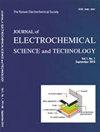将钴嵌入ZIF-67中制备钴纳米多孔碳复合材料作为锂离子电池电极材料
IF 3
4区 工程技术
Q3 ELECTROCHEMISTRY
Journal of electrochemical science and technology
Pub Date : 2021-07-08
DOI:10.33961/JECST.2020.01473
引用次数: 1
摘要
锂离子电池(LIBs)是由锂电池发展而来的一种可充电二次电池,锂离子在正负电极之间移动,实现外部电路的充放电。沸石咪唑盐骨架(ZIFs)是一种多孔晶体材料,其中有机咪唑酯与过渡金属交联形成骨架结构。本文以ZIF-67为牺牲模板,制备了纳米多孔碳(NPC)包覆的钴纳米粒子。用该方法制备了结构完整、形貌规则、尺寸均匀的Co/NPC复合材料。钴和氮掺杂碳的导电网络可以缩短锂离子的传输路径并呈现高导电性。此外,无定形碳具有更多的孔隙,这些孔隙可以在充电和放电过程中与电解质完全接触。同时,它还减少了循环过程中的体积膨胀,减缓了结构坍塌引起的容量衰减率。Co/NPC复合材料首次放电比容量高达3115mAh/g,在200mA/g的电流密度下,循环200可逆容量高达751.1mAh/g,具有优异的倍率和电阻性能。实验结果表明,Co/NPC复合材料提高了电极的导电性和电化学性能。钴基ZIF-67作为前驱体,为设计用于储能和电化学催化的高性能电极开辟了道路。本文章由计算机程序翻译,如有差异,请以英文原文为准。
Embedding Cobalt Into ZIF-67 to Obtain Cobalt-Nanoporous Carbon Composites as Electrode Materials for Lithium ion Battery
Lithium ion batteries (LIBs) is a kind of rechargeable secondary battery, developed from lithium battery, lithium ions move between the positive and negative electrodes to realize the charging and discharging of external circuits. Zeolitic imidaz-olate frameworks (ZIFs) are porous crystalline materials in which organic imidazole esters are cross-linked to transition metals to form a framework structure. In this article, ZIF-67 is used as a sacrificial template to prepare nano porous carbon (NPC) coated cobalt nanoparticles. The final product Co/NPC composites with complete structure, regular morphology and uniform size were obtained by this method. The conductive network of cobalt and nitrogen doped carbon can shorten the lithium ion transport path and present high conductivity. In addition, amorphous carbon has more pores that can be fully in contact with the electrolyte during charging and discharging. At the same time, it also reduces the volume expansion during the cycle and slows down the rate of capacity attenuation caused by structure collapse. Co/NPC composites first discharge specific capacity up to 3115 mA h/g, under the current density of 200 mA/g, circular 200 reversible capacity as high as 751.1 mA h/g, and the excellent rate and resistance performance. The experimental results show that the Co/NPC composite material improves the electrical conductivity and electrochemical properties of the electrode. The cobalt based ZIF-67 as the precursor has opened the way for the design of highly performance electrodes for energy storage and electrochemical catalysis.
求助全文
通过发布文献求助,成功后即可免费获取论文全文。
去求助
来源期刊

Journal of electrochemical science and technology
ELECTROCHEMISTRY-
CiteScore
6.30
自引率
8.10%
发文量
44
期刊介绍:
Covering fields:
- Batteries and Energy Storage
- Biological Electrochemistry
- Corrosion Science and Technology
- Electroanalytical Chemistry and Sensor Technology
- Electrocatalysis
- Electrochemical Capacitors & Supercapcitors
- Electrochemical Engineering
- Electrodeposition and Surface Treatment
- Environmental Science and Technology
- Fuel Cells
- Material Electrochemistry
- Molecular Electrochemistry and Organic Electrochemistry
- Physical Electrochemistry
- Solar Energy Conversion and Photoelectrochemistry
 求助内容:
求助内容: 应助结果提醒方式:
应助结果提醒方式:


